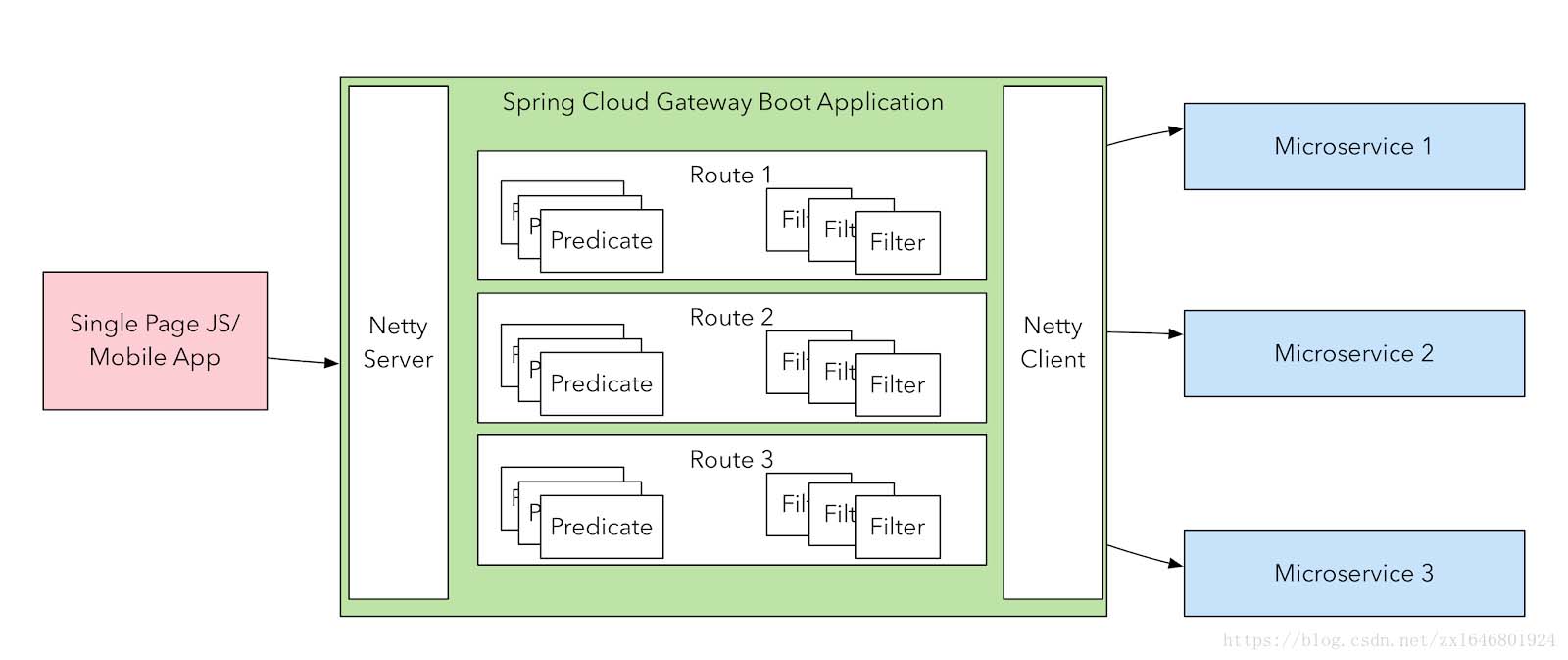前言
Spring Cloud Gateway是Spring官方基于Spring 5.0,Spring Boot 2.0和Project Reactor等技术开发的网关,Spring Cloud Gateway旨在为微服务架构提供一种简单而有效的统一的API路由管理方式。Spring Cloud Gateway作为Spring Cloud生态系中的网关,目标是替代Netflix ZUUL,其不仅提供统一的路由方式,并且基于Filter链的方式提供了网关基本的功能,例如:安全,监控/埋点,和限流等。

Spring Cloud Gateway 的特征:
Spring Cloud Gateway中的全局异常处理不能直接用@ControllerAdvice来处理,通过跟踪异常信息的抛出,找到对应的源码,自定义一些处理逻辑来符合业务的需求。
网关都是给接口做代理转发的,后端对应的都是REST API,返回数据格式都是JSON。如果不做处理,当发生异常时,Gateway默认给出的错误信息是页面,不方便前端进行异常处理。
需要对异常信息进行处理,返回JSON格式的数据给客户端。下面先看实现的代码,后面再跟大家讲下需要注意的地方。
自定义异常处理逻辑:
package com.cxytiandi.gateway.exception;
import java.util.HashMap;
import java.util.Map;
import org.springframework.boot.autoconfigure.web.ErrorProperties;
import org.springframework.boot.autoconfigure.web.ResourceProperties;
import org.springframework.boot.autoconfigure.web.reactive.error.DefaultErrorWebExceptionHandler;
import org.springframework.boot.web.reactive.error.ErrorAttributes;
import org.springframework.context.ApplicationContext;
import org.springframework.http.HttpStatus;
import org.springframework.web.reactive.function.server.RequestPredicates;
import org.springframework.web.reactive.function.server.RouterFunction;
import org.springframework.web.reactive.function.server.RouterFunctions;
import org.springframework.web.reactive.function.server.ServerRequest;
import org.springframework.web.reactive.function.server.ServerResponse;
/**
* 自定义异常处理
*
* <p>异常时用JSON代替HTML异常信息<p>
*
* @author yinjihuan
*
*/
public class JsonExceptionHandler extends DefaultErrorWebExceptionHandler {
public JsonExceptionHandler(ErrorAttributes errorAttributes, ResourceProperties resourceProperties,
ErrorProperties errorProperties, ApplicationContext applicationContext) {
super(errorAttributes, resourceProperties, errorProperties, applicationContext);
}
/**
* 获取异常属性
*/
@Override
protected Map<String, Object> getErrorAttributes(ServerRequest request, boolean includeStackTrace) {
int code = 500;
Throwable error = super.getError(request);
if (error instanceof org.springframework.cloud.gateway.support.NotFoundException) {
code = 404;
}
return response(code, this.buildMessage(request, error));
}
/**
* 指定响应处理方法为JSON处理的方法
* @param errorAttributes
*/
@Override
protected RouterFunction<ServerResponse> getRoutingFunction(ErrorAttributes errorAttributes) {
return RouterFunctions.route(RequestPredicates.all(), this::renderErrorResponse);
}
/**
* 根据code获取对应的HttpStatus
* @param errorAttributes
*/
@Override
protected HttpStatus getHttpStatus(Map<String, Object> errorAttributes) {
int statusCode = (int) errorAttributes.get("code");
return HttpStatus.valueOf(statusCode);
}
/**
* 构建异常信息
* @param request
* @param ex
* @return
*/
private String buildMessage(ServerRequest request, Throwable ex) {
StringBuilder message = new StringBuilder("Failed to handle request [");
message.append(request.methodName());
message.append(" ");
message.append(request.uri());
message.append("]");
if (ex != null) {
message.append(": ");
message.append(ex.getMessage());
}
return message.toString();
}
/**
* 构建返回的JSON数据格式
* @param status 状态码
* @param errorMessage 异常信息
* @return
*/
public static Map<String, Object> response(int status, String errorMessage) {
Map<String, Object> map = new HashMap<>();
map.put("code", status);
map.put("message", errorMessage);
map.put("data", null);
return map;
}
}覆盖默认的配置:
package com.cxytiandi.gateway.exception;
import java.util.Collections;
import java.util.List;
import org.springframework.beans.factory.ObjectProvider;
import org.springframework.boot.autoconfigure.web.ResourceProperties;
import org.springframework.boot.autoconfigure.web.ServerProperties;
import org.springframework.boot.context.properties.EnableConfigurationProperties;
import org.springframework.boot.web.reactive.error.ErrorAttributes;
import org.springframework.boot.web.reactive.error.ErrorWebExceptionHandler;
import org.springframework.context.ApplicationContext;
import org.springframework.context.annotation.Bean;
import org.springframework.context.annotation.Configuration;
import org.springframework.core.Ordered;
import org.springframework.core.annotation.Order;
import org.springframework.http.codec.ServerCodecConfigurer;
import org.springframework.web.reactive.result.view.ViewResolver;
/**
* 覆盖默认的异常处理
*
* @author yinjihuan
*
*/
@Configuration
@EnableConfigurationProperties({ServerProperties.class, ResourceProperties.class})
public class ErrorHandlerConfiguration {
private final ServerProperties serverProperties;
private final ApplicationContext applicationContext;
private final ResourceProperties resourceProperties;
private final List<ViewResolver> viewResolvers;
private final ServerCodecConfigurer serverCodecConfigurer;
public ErrorHandlerConfiguration(ServerProperties serverProperties,
ResourceProperties resourceProperties,
ObjectProvider<List<ViewResolver>> viewResolversProvider,
ServerCodecConfigurer serverCodecConfigurer,
ApplicationContext applicationContext) {
this.serverProperties = serverProperties;
this.applicationContext = applicationContext;
this.resourceProperties = resourceProperties;
this.viewResolvers = viewResolversProvider.getIfAvailable(Collections::emptyList);
this.serverCodecConfigurer = serverCodecConfigurer;
}
@Bean
@Order(Ordered.HIGHEST_PRECEDENCE)
public ErrorWebExceptionHandler errorWebExceptionHandler(ErrorAttributes errorAttributes) {
JsonExceptionHandler exceptionHandler = new JsonExceptionHandler(
errorAttributes,
this.resourceProperties,
this.serverProperties.getError(),
this.applicationContext);
exceptionHandler.setViewResolvers(this.viewResolvers);
exceptionHandler.setMessageWriters(this.serverCodecConfigurer.getWriters());
exceptionHandler.setMessageReaders(this.serverCodecConfigurer.getReaders());
return exceptionHandler;
}
}注意点
异常时如何返回JSON而不是HTML?
在org.springframework.boot.autoconfigure.web.reactive.error.DefaultErrorWebExceptionHandler中的getRoutingFunction()方法就是控制返回格式的,原代码如下:
@Override
protected RouterFunction<ServerResponse> getRoutingFunction(
ErrorAttributes errorAttributes) {
return RouterFunctions.route(acceptsTextHtml(), this::renderErrorView)
.andRoute(RequestPredicates.all(), this::renderErrorResponse);
}这边优先是用HTML来显示的,想用JSON的改下就可以了,如下:
protected RouterFunction<ServerResponse> getRoutingFunction(ErrorAttributes errorAttributes) {
return RouterFunctions.route(RequestPredicates.all(), this::renderErrorResponse);
}getHttpStatus需要重写
原始的方法是通过status来获取对应的HttpStatus的,代码如下:
protected HttpStatus getHttpStatus(Map<String, Object> errorAttributes) {
int statusCode = (int) errorAttributes.get("status");
return HttpStatus.valueOf(statusCode);
}如果我们定义的格式中没有status字段的话,这么就会报错,找不到对应的响应码,要么返回数据格式中增加status子段,要么重写,我这边返回的是code,所以要重写,代码如下:
@Override
protected HttpStatus getHttpStatus(Map<String, Object> errorAttributes) {
int statusCode = (int) errorAttributes.get("code");
return HttpStatus.valueOf(statusCode);
}总结
以上就是这篇文章的全部内容了,希望本文的内容对大家的学习或者工作具有一定的参考学习价值,如果有疑问大家可以留言交流,谢谢大家对亿速云的支持。
亿速云「云服务器」,即开即用、新一代英特尔至强铂金CPU、三副本存储NVMe SSD云盘,价格低至29元/月。点击查看>>
免责声明:本站发布的内容(图片、视频和文字)以原创、转载和分享为主,文章观点不代表本网站立场,如果涉及侵权请联系站长邮箱:is@yisu.com进行举报,并提供相关证据,一经查实,将立刻删除涉嫌侵权内容。